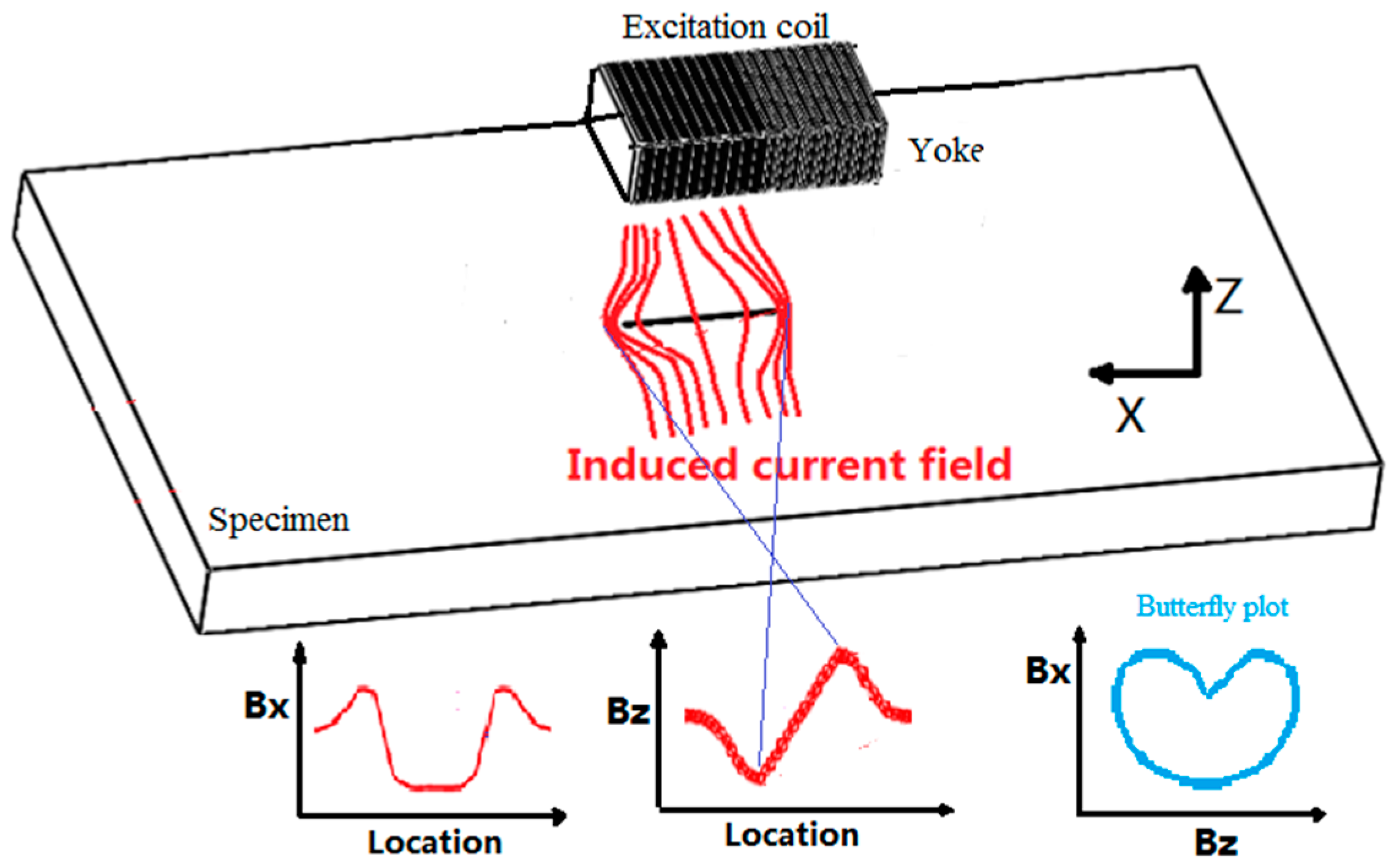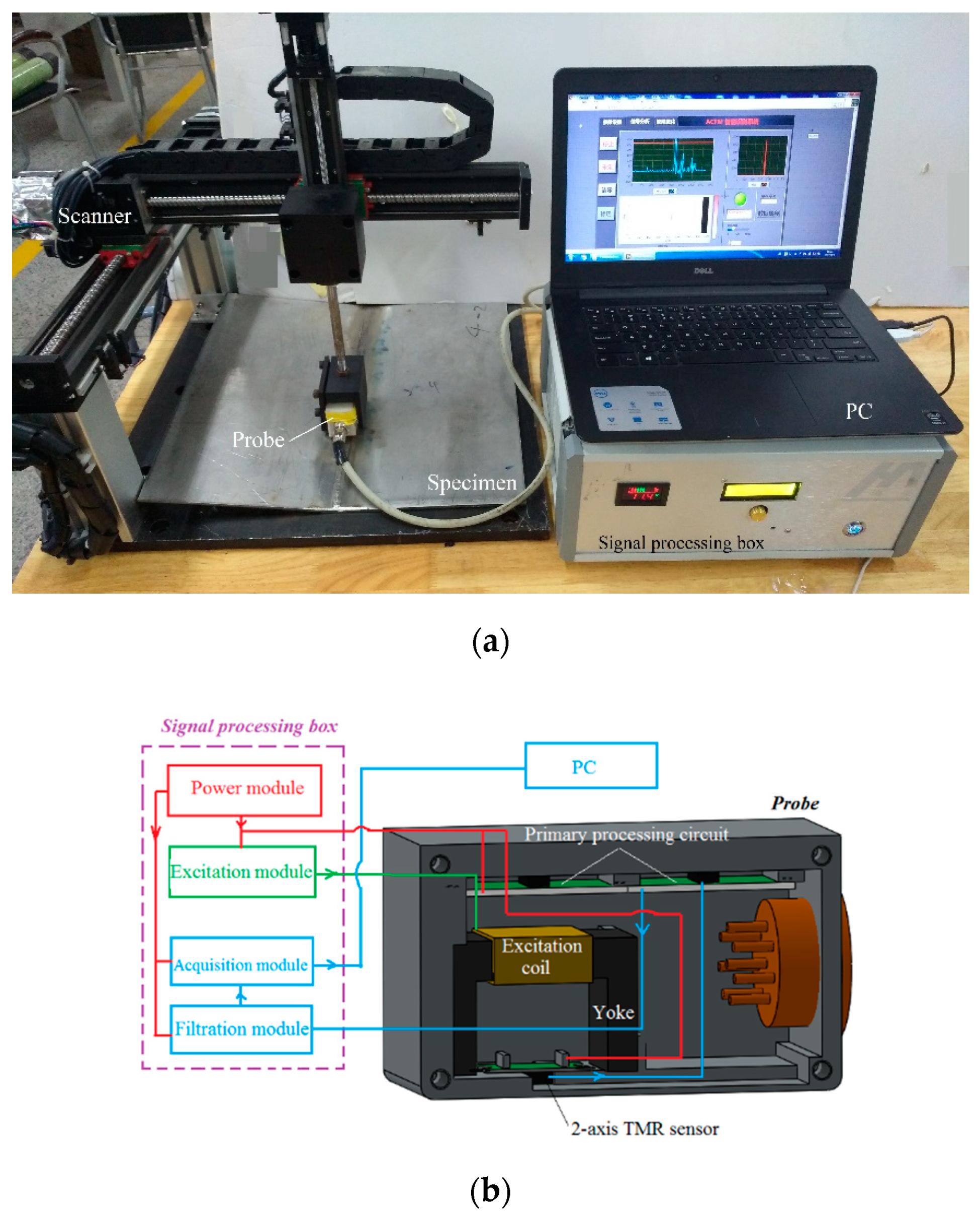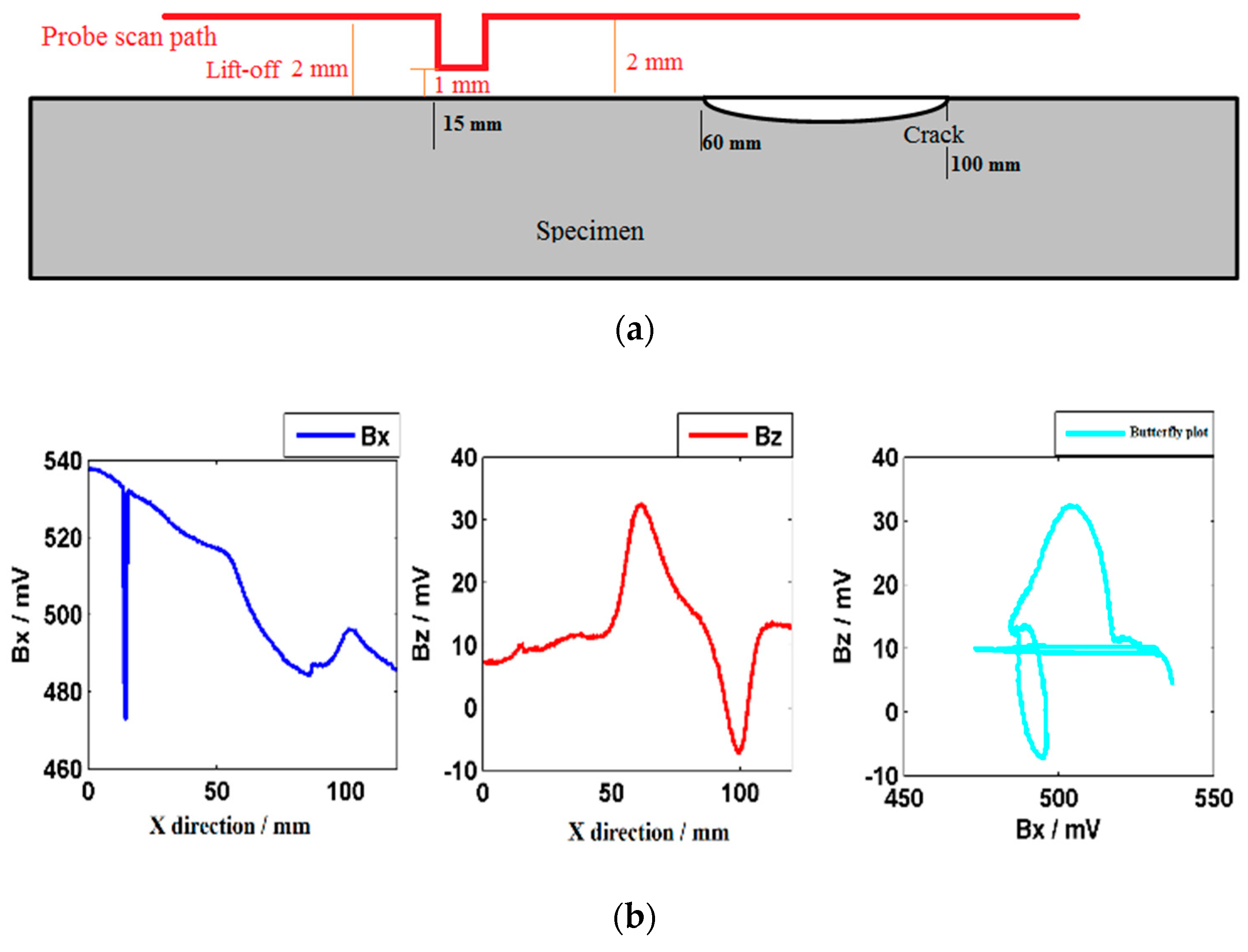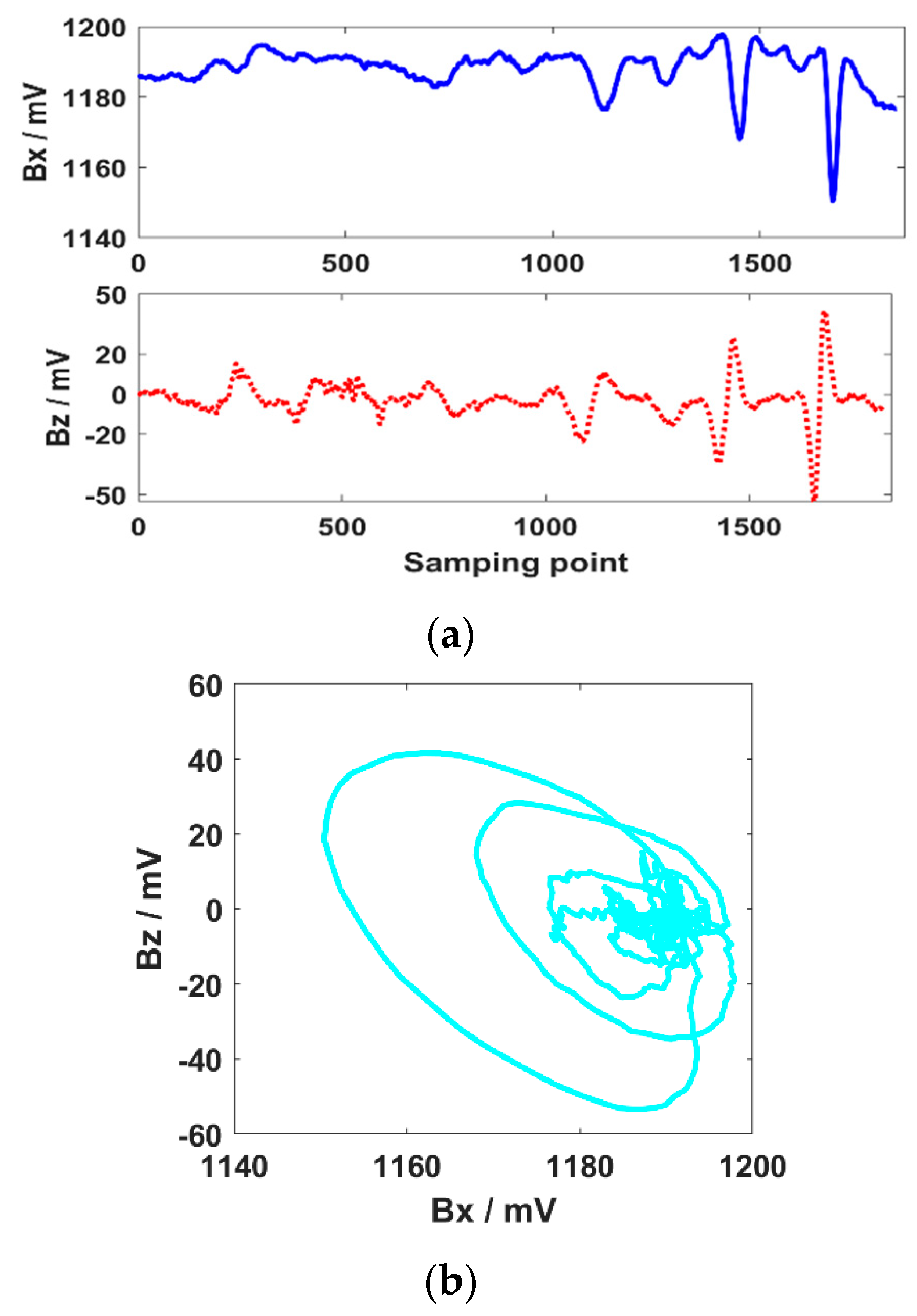Identification of Tiny Surface Cracks in a Rugged Weld by Signal Gradient Algorithm Using the ACFM Technique
Abstract
:1. Introduction
2. Insensitive Signal to Lift-off Variations
2.1. Simulation Model
2.2. System Set Up
2.3. Lift-Off Variation Experiments
3. Signal Gradient Algorithm
3.1. Detection of Tiny Cracks in the Weld and the HAZ
3.2. Signal Gradient Algorithm
3.3. Discussions
4. Conclusions
Author Contributions
Funding
Acknowledgments
Conflicts of Interest
References
- Taheri, H.; Kilpatrick, M.; Norvalls, M.; Harper, W.J.; Koester, L.W.; Bigelow, T.A.; Bond, L.J. Investigation of nondestructive testing methods for friction stir welding. Metals 2019, 9, 624. [Google Scholar] [CrossRef] [Green Version]
- Wang, R.; Liu, Z.H.; Wu, J.F.; Jiang, B.Y.; Li, B. Research on phased array ultrasonic testing on CFETR vacuum vessel welding. Fusion Eng. Des. 2019, 139, 124–127. [Google Scholar] [CrossRef]
- Gao, X.D.; Du, L.L.; Ma, N.; Zhou, X.H.; Wang, C.Y.; Gao, P.P. Magneto-optical imaging characteristics of weld defects under alternating and rotating magnetic field excitation. Opt. Laser Technol. 2019, 112, 188–197. [Google Scholar] [CrossRef]
- Andreaus, U.; Baragatti, P.; Casini, P.; Iacoviello, D. Experimental damage evaluation of open and fatigue cracks of multi-cracked beams by using wavelet transform of static response via image analysis. Struct. Control Health Monit. 2016, 105, 227–244. [Google Scholar] [CrossRef]
- Shelikhov, G.S.; Glazkov, Y.A. On the improvement of examination questions during the nondestructive testing of magnetic powder. Russ. J. Nondestr. Test. 2011, 47, 112–117. [Google Scholar] [CrossRef]
- Pashagin, A.I.; Shcherbinin, V.E. Indication of magnetic fields with the use of galvanic currents in magnetic-powder nondestructive testing. Russ. J. Nondestr. Test. 2012, 48, 528–531. [Google Scholar] [CrossRef]
- Takiy, A.E.; Kitano, C.; Higuti, R.T.; Granja, S.C.G.; Prado, V.T.; Elvira, L.; Martinez-Graullera, Ó. Ultrasound imaging of immersed plates using high-order Lamb modes at their low attenuation frequency bands. Mech. Syst. Sign. Process. 2017, 96, 321–332. [Google Scholar] [CrossRef] [Green Version]
- Ricci, M.; Silipigni, G.; Ferrigno, L.; Laracca, M.; Adewale, I.; Tian, G.Y. Evaluation of the lift-off robustness of eddy current imaging techniques. NDT E Int. 2017, 85, 43–52. [Google Scholar] [CrossRef]
- Katoozian, D.; Hasanzadeh, R.P.R. A fuzzy error characterization approach for crack depth profile estimation in metallic structures through ACFM data. IEEE T. Magn. 2017, 53, 6202100. [Google Scholar] [CrossRef]
- Lewis, A.M.; Michael, D.H.; Lugg, M.C.; Collins, R. Thin-skin electromagnetic fields around surface-breaking cracks in metals. J. Appl. Phys. 1988, 64, 3777–3784. [Google Scholar] [CrossRef] [Green Version]
- Raine, A. Cost benefit applications using the ACFM technique. Insight 2002, 44, 180–181. [Google Scholar]
- Akbari-Khezri, A.; Sadeghi, S.H.H.; Moini, R.; Sharifi, M. An efficient modeling technique for analysis of AC field measurement probe output signals to improve crack detection and sizing in cylindrical metallic structures. J. Nondestr. Eval. 2016, 35, 9. [Google Scholar] [CrossRef]
- Deng, Z.Y.; Sun, Y.H.; Yang, Y.; Kang, Y.H. Effects of surface roughness on magnetic flux leakage testing of micro-cracks. Meas. Sci. Technol. 2017, 28, 045003. [Google Scholar] [CrossRef]
- Lu, M.Y.; Xu, H.Y.; Zhu, W.Q.; Yin, L.Y.; Qian, Z.; Peyton, A.J.; Yin, W.L. Conductivity lift-off invariance and measurement of permeability for ferrite metallic plates. NDT E Int. 2018, 95, 36–44. [Google Scholar] [CrossRef]
- Andreaus, U.; Casini, P.; Vestroni, F. Nonlinear features in the dynamic response of a cracked beam under harmonic forcing. In Proceeding of the ASME 2005 International Design Engineering Technical Conferences & Computers and Information in Engineering Conference (DETC’05), Long Beach, CA, USA, 24–28 September 2005; pp. 2083–2089. [Google Scholar]
- Shen, J.L.; Zhou, L.; Rowshandel, H.; Nicholson, G.L.; Davis, C.L. Determining the propagation angle for non-vertical surface-breaking cracks and its effect on crack sizing using an ACFM sensor. Meas. Sci. Technol. 2015, 26, 115604. [Google Scholar] [CrossRef]
- Smith, M.; Laenen, C. Inspection of nuclear storage tanks using remotely deployed ACFMT. Insight 2007, 49, 17–20. [Google Scholar] [CrossRef]
- Mostafavi, R.F.; Mirshekar-Syahkal, D. AC fields around short cracks in metals induced by rectangular coils. IEEE Trans. Magn. 1999, 35, 2001–2006. [Google Scholar] [CrossRef]
- Yuan, X.A.; Li, W.; Chen, G.M.; Yin, X.K.; Yang, W.C.; Ge, J.H. Two-step interpolation algorithm for measurement of longitudinal cracks on pipe strings using circumferential current field testing system. IEEE Trans. Ind. Inform. 2018, 14, 394–402. [Google Scholar] [CrossRef]
- Leng, J.C.; Tian, H.X.; Zhou, G.Q.; Wu, Z.M. Joint detection of MMM and ACFM on critical parts of jack-up offshore platform. Ocean Eng. 2017, 35, 34–38. (In Chinese) [Google Scholar]
- Rowshandel, H.; Nicholson, G.L.; Shen, J.L.; Davis, C.L. Characterization of clustered cracks using an ACFM sensor and application of an artificial neural network. NDT E Int. 2018, 98, 80–88. [Google Scholar] [CrossRef]
- Yuan, X.A.; Li, W.; Chen, G.M.; Yin, X.K.; Jiang, W.Y.; Zhao, J.M.; Ge, J.H. Inspection of both inner and outer cracks in aluminum tubes using double frequency circumferential current field testing method. Mech. Syst. Sign. Process. 2019, 127, 16–34. [Google Scholar] [CrossRef]
- Tian, G.Y.; Sophian, A. Reduction of lift-off effects for pulsed eddy current. NDT E Int. 2005, 38, 319–324. [Google Scholar] [CrossRef]
- Yuan, X.A.; Li, W.; Chen, G.M.; Yin, X.K.; Ge, J.H. Frequency optimisation of circumferential current field testing system for highly-sensitive detection of Iongitudinal cracks on a pipe string. Insight 2017, 59, 378–382. [Google Scholar] [CrossRef]
- Li, Y.; Yan, B.; Li, D.; Li, Y.L.; Zhou, D.Q. Gradient-field pulsed eddy current probes for imaging of hidden corrosion in conductive structures. Sens. Actuators A Phys. 2016, 38, 251–265. [Google Scholar] [CrossRef]
- Li, Y.; Ren, S.T.; Yan, B.; Abidin, I.M.Z.; Wang, Y. Imaging of subsurface corrosion using gradient-field pulsed eddy current probes with uniform field excitation. Sensors 2017, 17, 1747. [Google Scholar] [CrossRef]
- Atzlesberger, J.; Zagar, B.G.; Cihal, R.; Brummayer, M.; Reisinger, P. Sub-surface defect detection in a steel sheet. Meas. Sci. Technol. 2013, 24, 084003. [Google Scholar] [CrossRef]
- AbdAlla, A.N.; Faraj, M.A.; Samsuri, F.; Rifai, D.; Ali, K.; Al-Douri, Y. Challenges in improving the performance of eddy current testing: Review. Meas. Control 2019, 52, 46–64. [Google Scholar] [CrossRef] [Green Version]














| No. | W1 | W2 | W3 | H1 | H2 | H3 |
|---|---|---|---|---|---|---|
| Depth/mm | 3.5 | 3.0 | 2.5 | 3.5 | 3.0 | 2.5 |
| No. | H4 | H5 | W4 | W5 | W6 |
|---|---|---|---|---|---|
| Length/mm | 1.0 | 2.0 | 4.0 | 6.0 | 8.0 |
© 2020 by the authors. Licensee MDPI, Basel, Switzerland. This article is an open access article distributed under the terms and conditions of the Creative Commons Attribution (CC BY) license (http://creativecommons.org/licenses/by/4.0/).
Share and Cite
Yuan, X.; Li, W.; Yin, X.; Chen, G.; Zhao, J.; Jiang, W.; Ge, J. Identification of Tiny Surface Cracks in a Rugged Weld by Signal Gradient Algorithm Using the ACFM Technique. Sensors 2020, 20, 380. https://doi.org/10.3390/s20020380
Yuan X, Li W, Yin X, Chen G, Zhao J, Jiang W, Ge J. Identification of Tiny Surface Cracks in a Rugged Weld by Signal Gradient Algorithm Using the ACFM Technique. Sensors. 2020; 20(2):380. https://doi.org/10.3390/s20020380
Chicago/Turabian StyleYuan, Xin’an, Wei Li, Xiaokang Yin, Guoming Chen, Jianming Zhao, Weiyu Jiang, and Jiuhao Ge. 2020. "Identification of Tiny Surface Cracks in a Rugged Weld by Signal Gradient Algorithm Using the ACFM Technique" Sensors 20, no. 2: 380. https://doi.org/10.3390/s20020380





